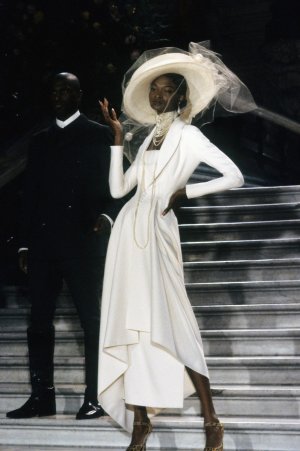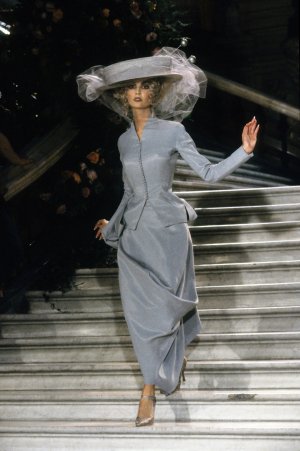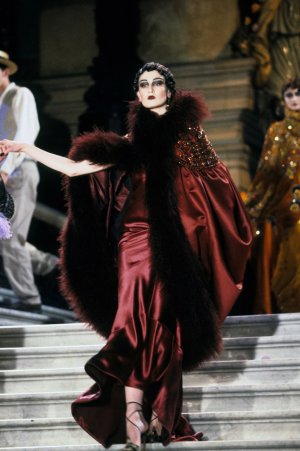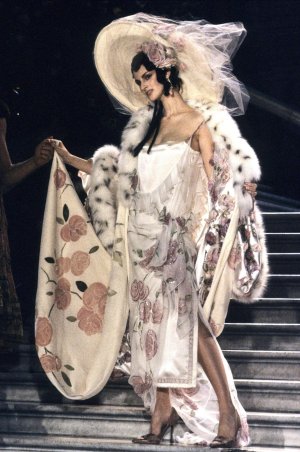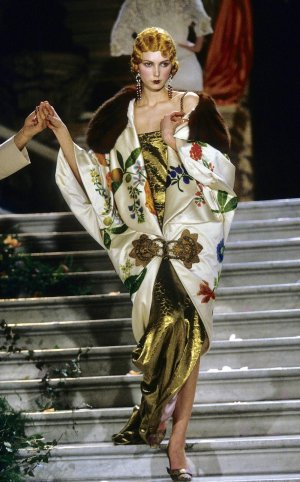svpernova
Well-Known Member
- Joined
- Sep 26, 2024
- Messages
- 107
- Reaction score
- 158
"A poetic tribute to the Marchesa Casati" designed by John Galliano. I didn't see this posted in this section so I decided to make a thread about it because it is one of the most iconic shows. I apologize if this has been posted beforehand or if I made a mistake.
Sharing the vision behind the show based on the Dior Catwalk book:
"John Galliano invited his audience to Paris's Opéra Garnier for a lavish spectacle inspired by the highly eccentric muse, heiress and arts patron Marchesa Luisa Casati, a great Italian lady from the beginning of this century, whose extraordinary personality.... made her famous throughout Europe, explained the collection notes. Known for her flaming red hair, smoky eye makeup and snow-white skin, she transformed her life into an oriental tale, living in a Venetian palace surrounded by monkeys, exotic birds, greyhounds and a snake she wore as a necklace
Painted by artists such as Giovanni Boldini, Kees van Dongen and Augustus John, the Marchesa, who declared she wanted to be a living work of art, also captivated poet Gabriele D'Annunzio, who nicknamed, her 'Core (after the maiden who was abducted by the god of hell, Hades, to become his wife and queen of the underworld), and counted artist and Ballets Russes costume designer Léon Bakst among her friends.
Accompanied by a cascade of rose petals on the grand marble staircase where it appeared, the first ensemble-baptized 'Maria Luisa (dite Core) - was 'a black crinoline dress so vast that fashion editors ducked as it moved past, to quote. The Times (see p. 285, top right).
Six different 'acts' followed. Act 1 was titled 'A pastoral, Sèvres-porcelain-style story, inspired by the small Trianon-influenced palace where the Marchesa used to live, and revisiting the 18th- century neo-Versailles taste for exquisite little painted white porcelain shepherdesses in a series of white and pastel day ensembles accessorized with porcelain medallions.
Act 11, 'English story in a country garden, saw an abundance of roses and foliage adorn ensembles with names such as "Sissinghurst' and 'Garsington. Act m Story of a voyage in first class, presented perfectly cut travel suits and travel dresses framed with huge creamy veiled boater hats, followed by a succession of gold lamé tango dresses with striking folds and gathers in Act IV (Lascivious story to a tango tune) and richly embroidered Poiret-inspired pyramid-line Ballets-Russes kimonos' with high funnel collars in Act v (Story of an Orientalist encounter with Balest
For the final act (Story of a fancy-dress hall at the Palazzo dei Leoni'), Galliano recreated the Marchesa Casati's own 'Pulcinella' dress (designed) for her by Bakst; see p. 283, bottom), and closed the collection with a grandiose light blue ball dress with hooped crinoline on which tiny pastel-coloured butterfly-shaped confetti were promptly showered for a spectacular finale. "
Sharing the vision behind the show based on the Dior Catwalk book:
"John Galliano invited his audience to Paris's Opéra Garnier for a lavish spectacle inspired by the highly eccentric muse, heiress and arts patron Marchesa Luisa Casati, a great Italian lady from the beginning of this century, whose extraordinary personality.... made her famous throughout Europe, explained the collection notes. Known for her flaming red hair, smoky eye makeup and snow-white skin, she transformed her life into an oriental tale, living in a Venetian palace surrounded by monkeys, exotic birds, greyhounds and a snake she wore as a necklace
Painted by artists such as Giovanni Boldini, Kees van Dongen and Augustus John, the Marchesa, who declared she wanted to be a living work of art, also captivated poet Gabriele D'Annunzio, who nicknamed, her 'Core (after the maiden who was abducted by the god of hell, Hades, to become his wife and queen of the underworld), and counted artist and Ballets Russes costume designer Léon Bakst among her friends.
Accompanied by a cascade of rose petals on the grand marble staircase where it appeared, the first ensemble-baptized 'Maria Luisa (dite Core) - was 'a black crinoline dress so vast that fashion editors ducked as it moved past, to quote. The Times (see p. 285, top right).
Six different 'acts' followed. Act 1 was titled 'A pastoral, Sèvres-porcelain-style story, inspired by the small Trianon-influenced palace where the Marchesa used to live, and revisiting the 18th- century neo-Versailles taste for exquisite little painted white porcelain shepherdesses in a series of white and pastel day ensembles accessorized with porcelain medallions.
Act 11, 'English story in a country garden, saw an abundance of roses and foliage adorn ensembles with names such as "Sissinghurst' and 'Garsington. Act m Story of a voyage in first class, presented perfectly cut travel suits and travel dresses framed with huge creamy veiled boater hats, followed by a succession of gold lamé tango dresses with striking folds and gathers in Act IV (Lascivious story to a tango tune) and richly embroidered Poiret-inspired pyramid-line Ballets-Russes kimonos' with high funnel collars in Act v (Story of an Orientalist encounter with Balest
For the final act (Story of a fancy-dress hall at the Palazzo dei Leoni'), Galliano recreated the Marchesa Casati's own 'Pulcinella' dress (designed) for her by Bakst; see p. 283, bottom), and closed the collection with a grandiose light blue ball dress with hooped crinoline on which tiny pastel-coloured butterfly-shaped confetti were promptly showered for a spectacular finale. "


